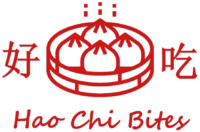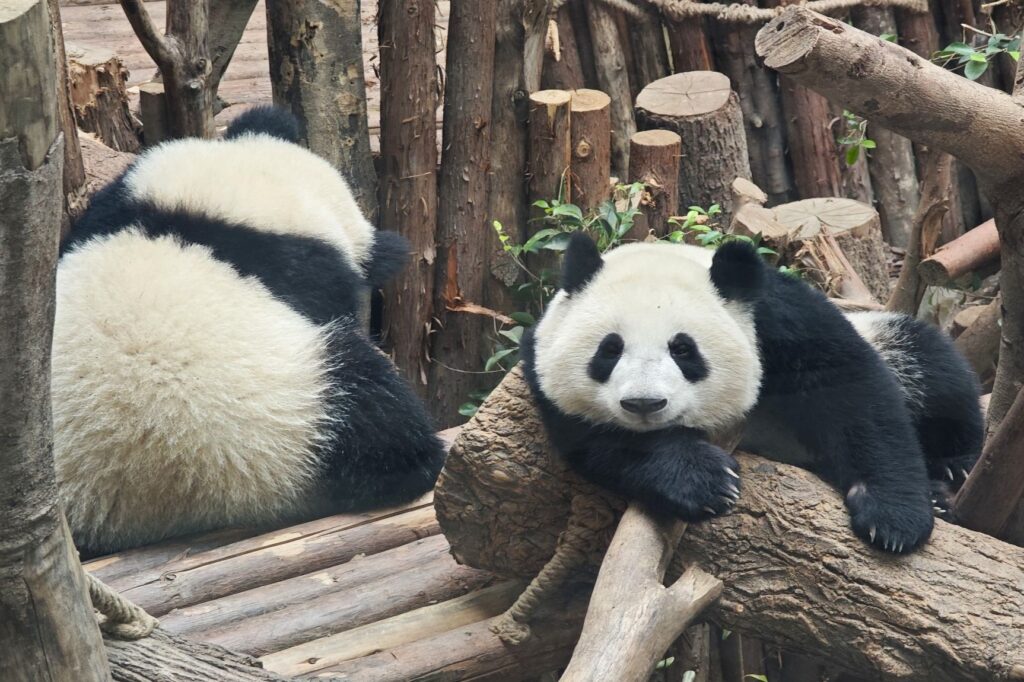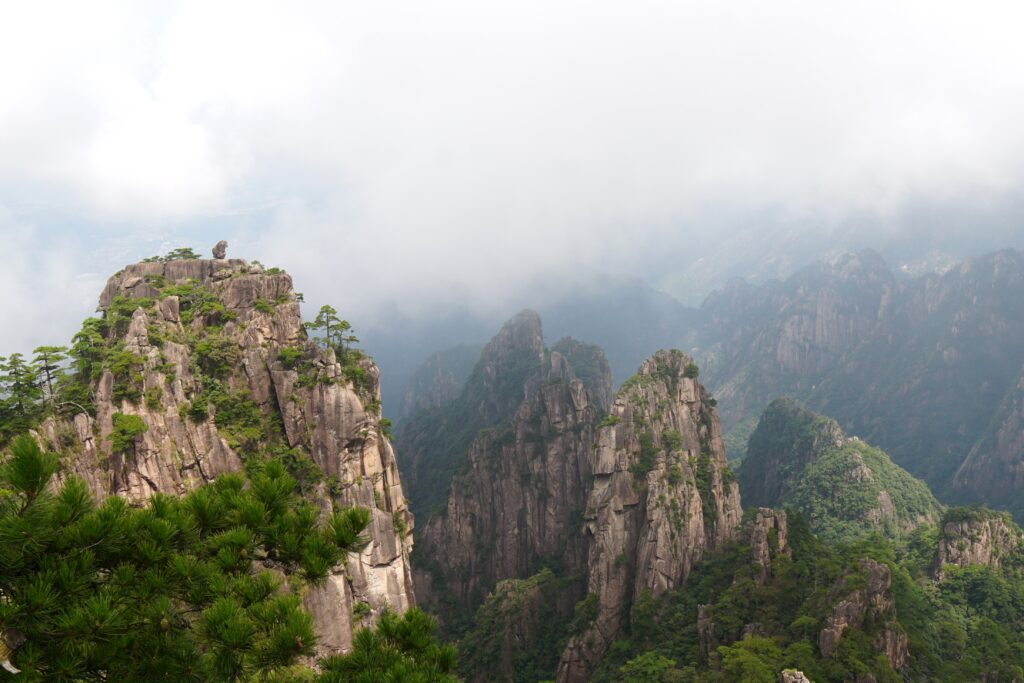If you’ve been following our posts, you’ve probably noticed our deep passion for Chinese cuisine. And if there’s one region that keeps popping up, it’s Sichuan. Home to one of China’s most famous culinary traditions—one of the country’s eight great cuisines—Sichuan is renowned for its bold, fiery flavors, its generous use of chili peppers and Sichuan peppercorns, and the signature tingling, numbing sensation.
But there’s much more to Sichuan than just its legendary food. This province is one of the most diverse in China, with stunning landscapes, a rich cultural heritage, and, of course, its most famous residents—giant pandas, the beloved icons of the WWF (World Wide Fund for Nature).
At the heart of Sichuan is Chengdu, one of the province’s two major cities, known for its laid-back, friendly vibe. Life here moves at a slower, more relaxed pace—quite a contrast to China’s bustling megacities like Beijing and Shanghai. And when it comes to food, Chengdu is the beating heart of Sichuan cuisine. In fact, its culinary heritage has earned a spot on UNESCO’s list of Intangible Cultural Heritage of Humanity, making it an absolute must-visit for any foodie.
Speaking of UNESCO, Chengdu’s metropolitan area isn’t just famous for its cuisine—it boasts three UNESCO World Heritage Sites: Mount Emei and the Leshan Giant Buddha (1996), Mount Qingcheng and Dujiangyan (2000), and the Sichuan Giant Panda Sanctuaries (2006).
With all this in mind, Chengdu has long been at the top of our travel bucket list for China. And in the fall of 2024, we finally made it happen! Now, we’re excited to take you along on our journey, share our best tips and insights, and, of course, dive deep into the incredible flavors of Sichuan cuisine.
You could easily spend one or even two weeks immersing yourself in this laid-back city, but if you’re shorter on time, here’s our carefully curated five-day itinerary:
Day 1: Pandas & Riverside Views
- Chengdu Research Base of Giant Panda Breeding – Start your trip with Chengdu’s most iconic residents: the giant pandas. Visit early in the morning when they are most active.
- Jiuyan Bridge (九眼桥) – End the day with a scenic walk along this riverside area, known for its illuminated bridges and lively nightlife.
Day 2: Taoist Mountains & Mystical Waters
- Mount Qingcheng (青城山) – A Taoist mountain retreat with lush forests and ancient temples. Hike or take the cable car for breathtaking views.
- Dujiangyan & Nanqiao Bridge (都江堰南桥) – Visit the historic Dujiangyan irrigation system and watch the mesmerizing “Blue Tears” in the evening.
- Wuhou Shrine (武侯祠) – Dive into the legacy of the Three Kingdoms era at this historic site dedicated to Zhuge Liang.
- Wide & Narrow Alleys (宽窄巷子) – Wander through charming Qing Dynasty streets lined with traditional teahouses, shops, and street food stalls.
- People’s Park (人民公园) & Heming Teahouse (鹤鸣茶舍) – Experience Chengdu’s relaxed lifestyle in the afternoon, with a cup of tea at this historic teahouse, famous for its open-air bamboo chairs, ear-cleaning services, and a glimpse into local leisure culture.
- Yu Shaoxia Hotpot (瑜少侠火锅) – A popular Sichuan-style hotpot spot near People’s Park.
- Take a day trip to Leshan Giant Buddha (乐山大佛), the world’s largest stone Buddha, carved into a cliffside overlooking the confluence of three rivers. You can hike up for a close view or take a boat tour for a panoramic perspective.
Day 5: Poetry, Shopping & Hotpot
- Du Fu Thatched Cottage (杜甫草堂) – Step into the poetic world of one of China’s greatest Tang Dynasty poets.
- Chunxi Road (春熙路), IFS, Taikoo Li (太古里) – Dive into Chengdu’s modern side with high-end shopping and trendy boutiques.
- Nine-Grid Hotpot (九宫格火锅) – Wrap up your trip with an authentic Sichuan hotpot experience in a traditional nine-grid pot.
Transit Tips
- Metro – Chengdu’s subway system is convenient and reaches most attractions.
- Airports
- Tianfu Airport (天府机场) – Farther from downtown and has international connections and direct flights from Shanghai. Take Metro Line 10 or 19 to reach the city center.
- Shuangliu Airport (双流机场) – Offer direct international flights and is closer to the city, with Metro Line 18 or 19 providing direct access to city center.
- Taxis – A taxi from Tianfu Airport to downtown takes about 50-60 minutes and costs around ¥100-150. From Shuangliu Airport, it’s about 30 minutes and costs ¥50-80.
Accommodation Tips
- Stay downtown near a metro station for easy access to attractions.
- Hotel price range:
- Budget: ¥200-400 per night
- Mid-range: ¥400-800 per night
- Luxury: ¥800+ per night
- Non-smoking rooms: International hotels typically offer them, but many local hotels do not. However, well-ventilated rooms rarely retain smoke smells.
- Robot room service: Many hotels now use robots for room deliveries🎬—an interesting, futuristic touch!
Best Season to Visit the Pandas
The ideal time to see pandas in action is during the cooler months—autumn, early spring, or winter. If you visit in September or during warmer days, be prepared for a lazier panda experience. Instead of climbing trees and rolling around outdoors, pandas will likely be chilling in air-conditioned enclosures, munching on bamboo. While you can still see them play on swings and tree trunks inside, the heat makes them less active. A key tip: go early in the morning! After midday, you’ll mostly see panda butts as they nap away.
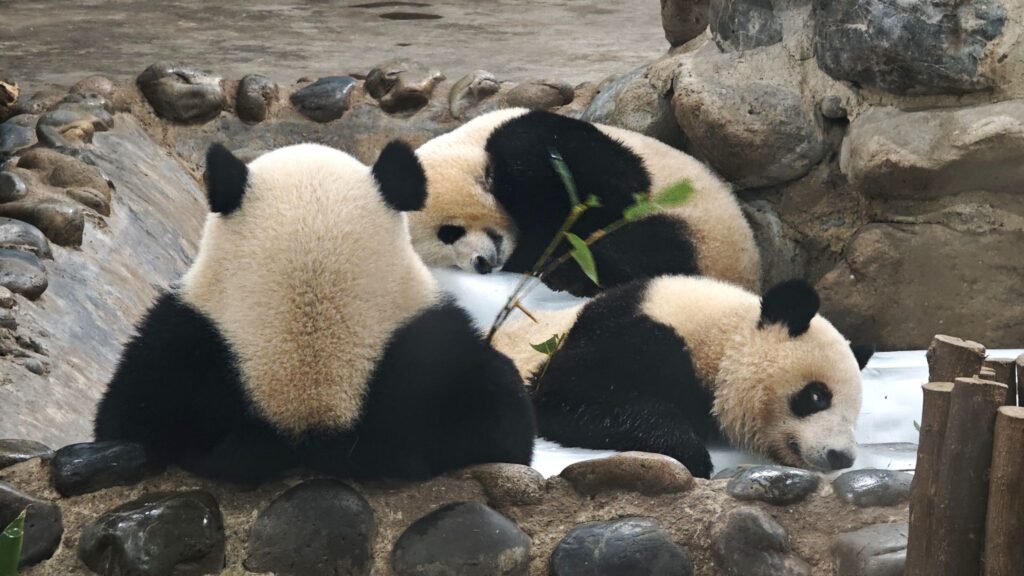
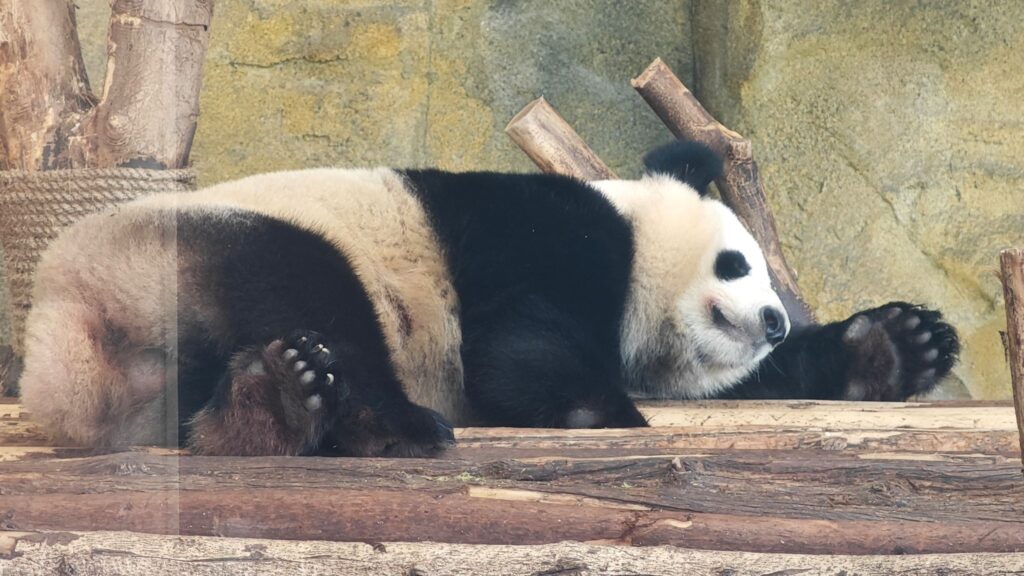
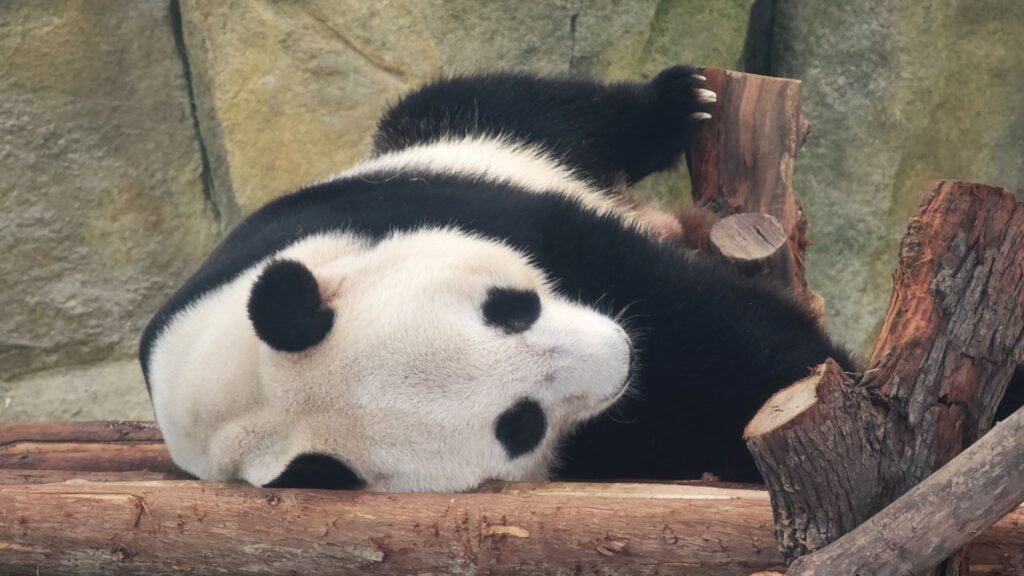
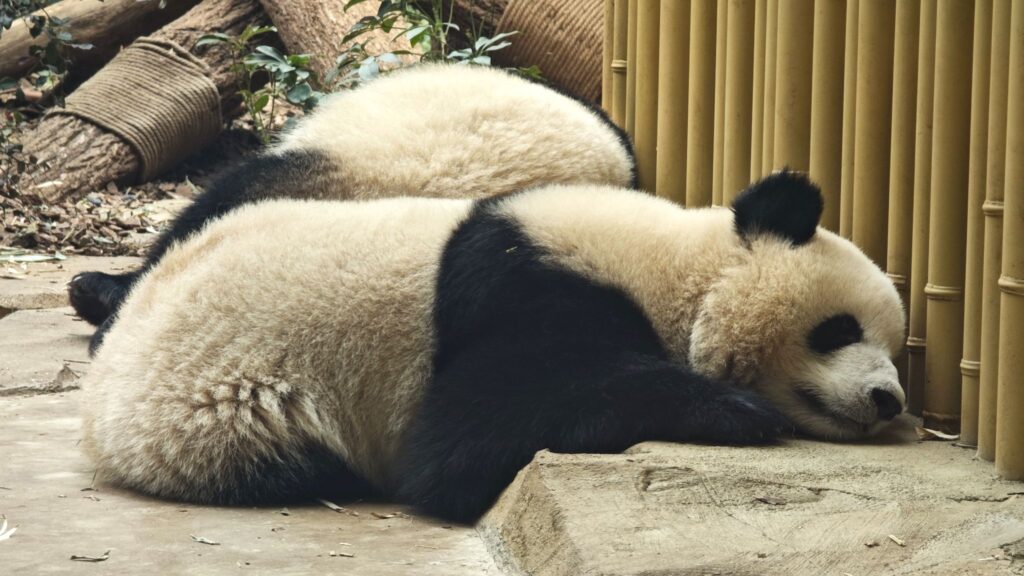
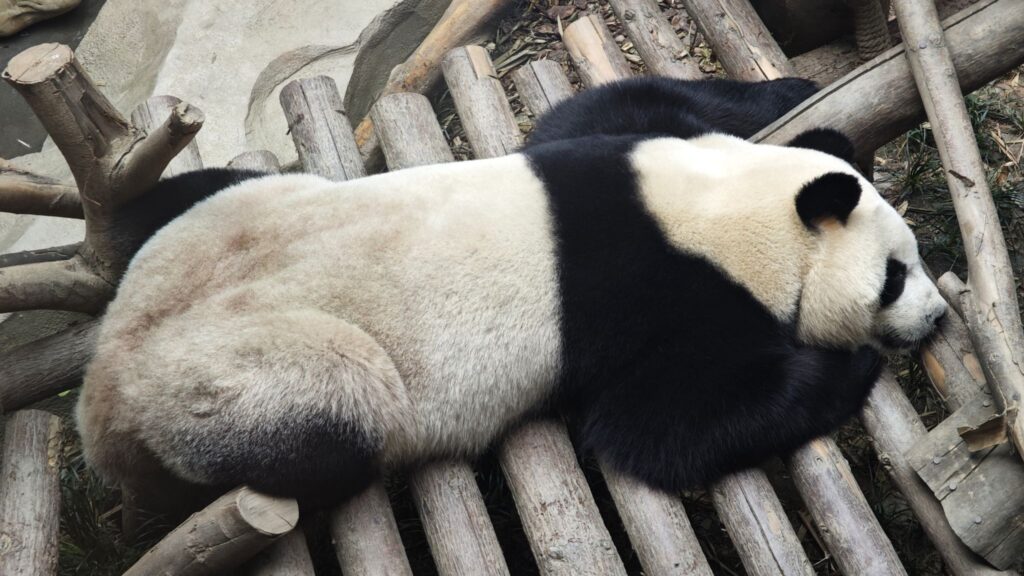
Where to See Pandas in Chengdu?
1. Chengdu Research Base of Giant Panda Breeding
📍 Location: Within Chengdu city
⏰ Opening Hours: 8:00 AM – 5:00 PM
🎟️ Tickets: Online reservation required (via WeChat or ask your hotel for help. No on-site sales available)
🚖 Getting There:
- By taxi: Costs around ¥40-60. However, taxis can’t drop you off directly at the entrance, so be prepared for a short 10-minute walk.
- By subway: Take Line 3 to Panda Avenue Station (熊猫大道站 Xióngmāo Dàdào Zhàn), then transfer to a shuttle bus or taxi.
🚶 Inside the park:
Food options inside are limited, so bring your own snacks and water. Water can be refilled for free within the park, but the park is quite large, and there aren’t many spots to refill.
The panda base is huge, so we recommend getting a sightseeing bus ticket at the entrance. This allows you to hop on and off instead of walking the entire park.
Here’s a suggested no-backtracking route to help you navigate:
South Gate (南门) → No. 6 Villa (6号别墅) → Sun Nursery Room (太阳产房) → No. 3 Villa (3号别墅) → No. 5 Villa (5号别墅) → Baby Panda House (小熊猫产房) → Moon Nursery Room (月亮产房) → Victory Hall (胜日馆) → Cloud Hall (云日馆) → Rising Sun Hall (旭日馆) → Reflection Hall (映日馆) → Star Nursery Room (星星产房) → Starry Hall (星汉馆) → Moon Gazing Hall (揽月馆) → West Gate Exit (西门出).
Please refer to the Chinese names of each spot, as the English versions may not always be up-to-date.Some of the sites may be closed at certain times of the year.
✨ Highlights:
- You can see pandas of all ages, from newborn cubs to playful juveniles and full-grown adults.
- You’ll also see red pandas, which are smaller, fluffier cousins of giant pandas.
- It’s home to Hua Hua (花花), one of China’s most famous pandas – a round, good-tempered panda who’s a social media star in China.
⚠️ Downsides:
- Pandas are 5–15 meters away, making close-up photos tricky.
- It gets very crowded, so if one exhibit has a long queue, skip to another—there are plenty of pandas to see!
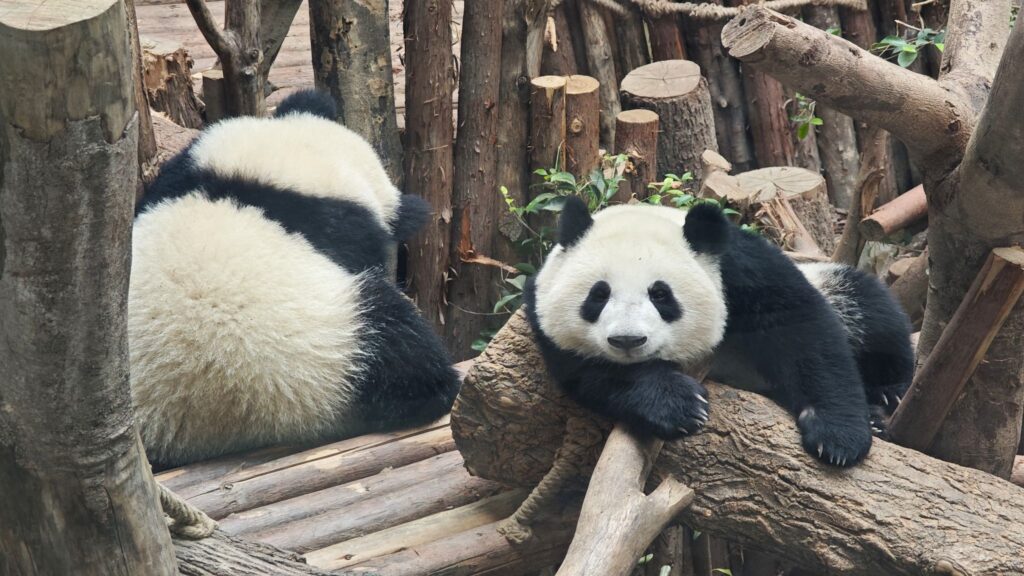
2. Dujiangyan Panda Valley
📍 Location: Dujiangyan, near Chengdu
⏰ Opening Hours: 8:10 AM – 5:00 PM
🎟️ Tickets: Online reservation recommended
🚆 Getting There:
- Take a high-speed train from Chengdu Xipu Station to Liduigongyuan Station.
- From there, a 10-minute taxi ride (~¥20) takes you to Panda Valley.
🚶 Inside the park:
- No sightseeing buses, so wear comfortable shoes!
- Food is not allowed in the panda area but can be stored and eaten later.
- Hard to find taxis after leaving, so use DiDi (China’s version of Uber).
✨ Highlights:
- Fewer crowds and fresher air compared to the Chengdu Research Base.
- Some pandas roam freely in the panda zone, meaning you could see them just half a meter away, napping or playing!
- Close to Dujiangyan, a UNESCO World Heritage Site, so you can combine both trips.
⚠️ Downsides:
- Fewer pandas (about 20).
- Harder to get to, and rainy days can dampen the experience.
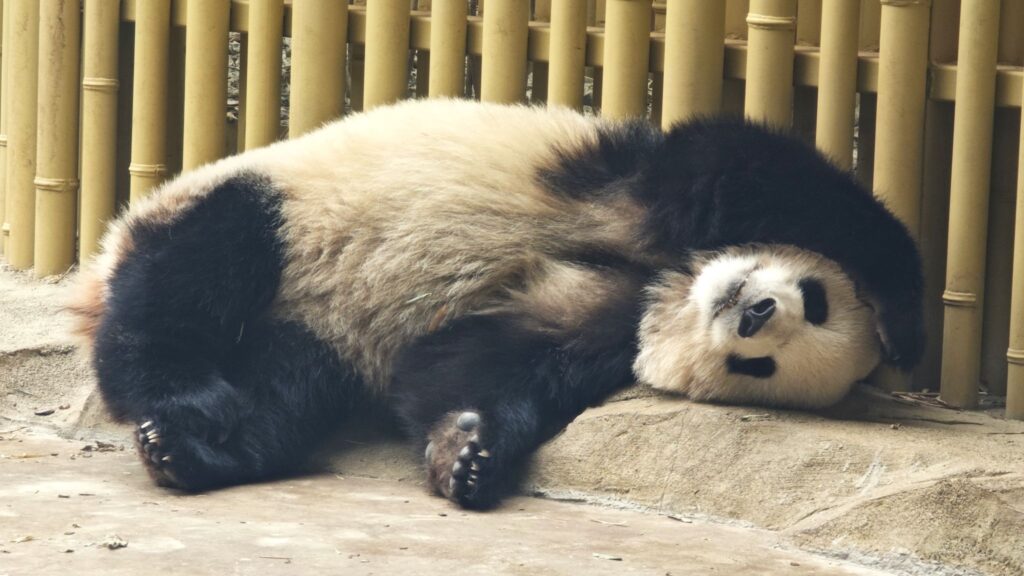
Panda Fun Facts! 🐼
Pandas are found in the wild, but only in China, with fewer than 2,000 remaining in the wild, primarily in Sichuan, Shaanxi, and Gansu provinces. They have a unique diet, with 99% of it consisting of bamboo, although they sometimes enjoy fruits and eggs. Due to their low-nutrient diet, pandas move slowly to conserve energy. However, young pandas can be surprisingly agile when playing!

One of the reasons pandas are so precious is their very low birth rate. Female pandas are only fertile once a year for 24–72 hours, and since they struggle to mate naturally, breeding programs often require artificial insemination to help boost the population. As a result, only about 20–30 baby pandas are born worldwide each year. Thankfully, due to successful conservation efforts, pandas are no longer classified as “endangered” but as “vulnerable.” That said, habitat loss continues to be a significant challenge to their survival.
While pandas are adorable, they can be dangerous. Their jaws are stronger than that of a lion’s! Though pandas are shy and rarely attack in the wild, there have been instances of captive pandas biting people, so it’s best not to try hugging them. So, while socking in the overdose of cuteness🎬, remember— these cuddly creatures can be tougher than they look🎬! (🐼 Click links to watch pandas in action! 🎬)
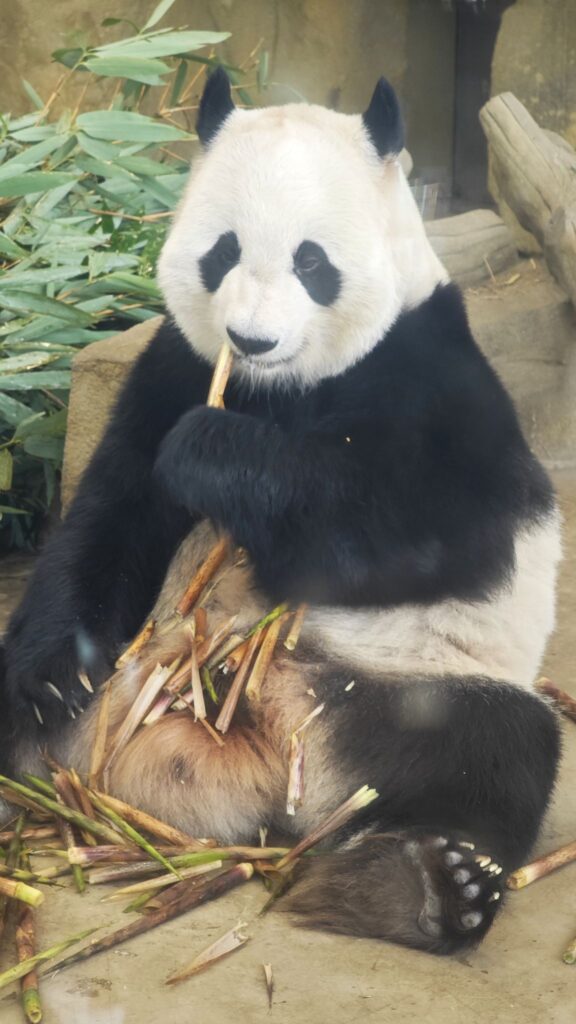
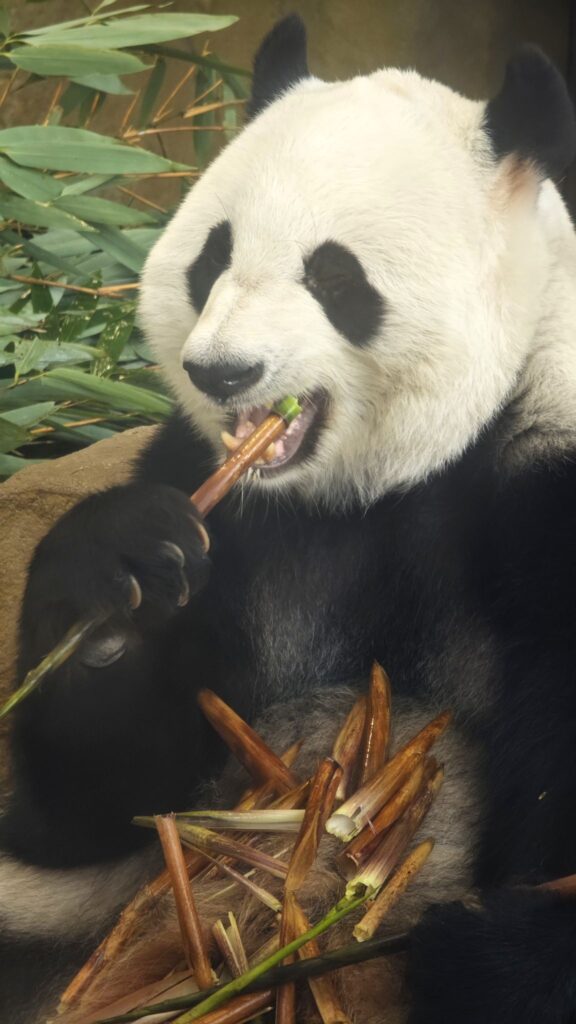
Chengdu Nights: Jiuyan Bridge and Beyond
Chengdu is a city that thrives after dark, and nowhere captures its lively night scene better than Jiuyan Bridge (九眼桥🎬). While technically a bridge, Jiuyan Bridge is actually a sprawling nightlife hub stretching from Hejiang Pavilion (合江亭) to Wangjianglou Park (望江楼公园). It is the epitome of Chengdu’s dazzling nightlife—a place that pulses with youth, energy, and spontaneity, embracing restless souls seeking a moment of escape beneath the neon glow.
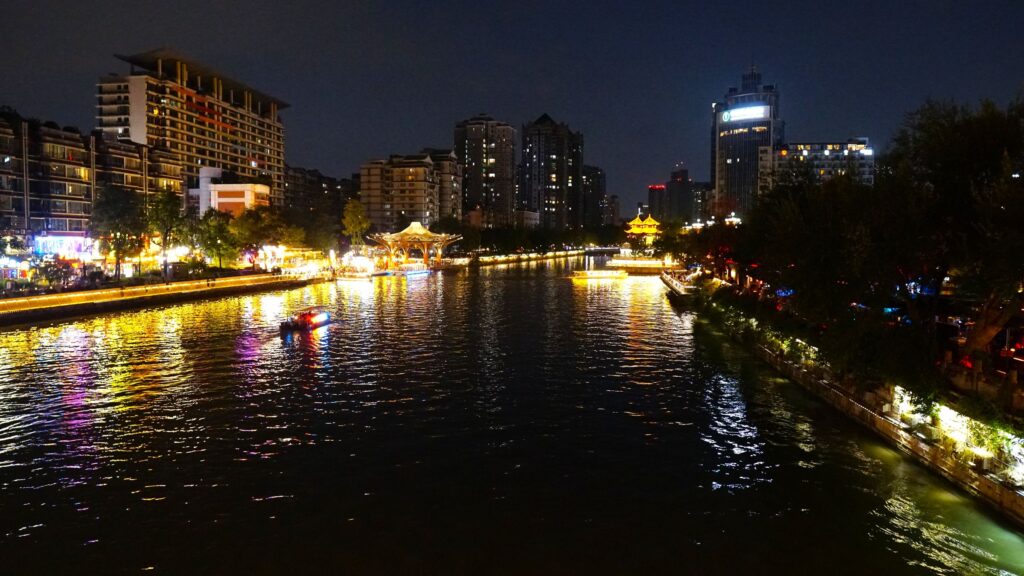
After a day of panda-watching, if you still have energy to spare, Jiuyanqiao is the right spot to experience Chengdu’s after-dark magic.
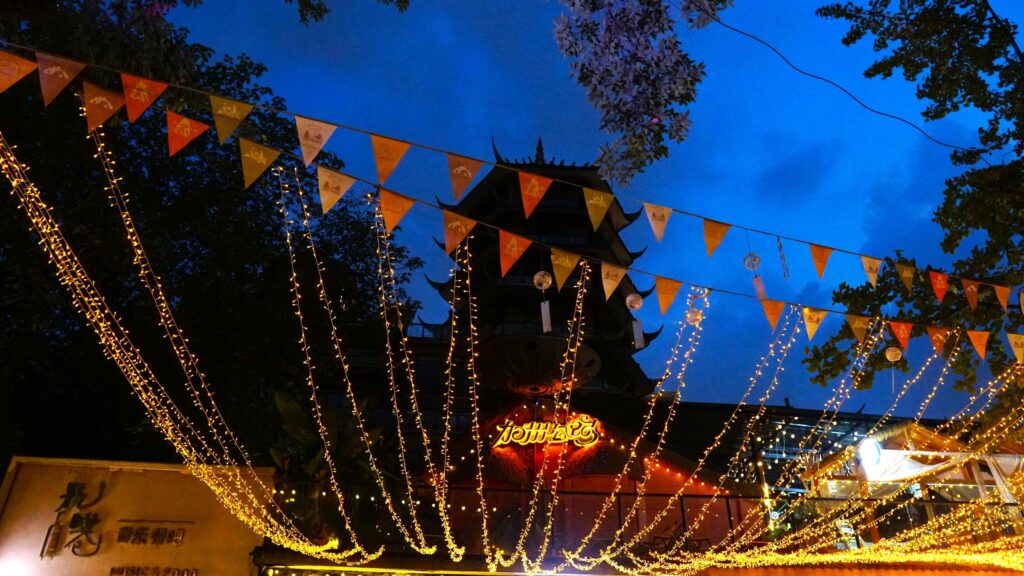
🚆 How to Get There
Arrive at Niuwangmiao Station (牛王庙站, Exit G) and walk for 10 minutes to reach Jiuyan Bridge. Here’s a suggested route:
- Start at Anshun Lang Bridge (安顺廊桥) from Jiuyan Bridge.
- Walk along Binjiang East Road (滨江西路), enjoying the neon reflections across the river and the buzzing “Bar Street (酒吧一条街)”.
- Cross Anshun Lang Bridge (安顺廊桥) and head towards Music Square (音乐广场), where Hejiang Pavilion (合江亭) stands elegantly by the water.
- For a fairytale-like experience, take the Jinjiang Night Cruise (锦江夜游) from Dongmen Pier (东门码头). The 30-minute ride glides past Hejiang Pavilion (合江亭), Jinjiang Park (锦江公园), and finally Jiuyan Bridge before returning. Along the way, you’ll see neon-lit buildings, light shows, and dreamlike riverside performances. Price is 118 RMB (full ticket).
- Finally, end the night with a drink (or a few) at Bar Street (酒吧一条街), enjoying the electrifying nightlife.
Jiuyan Bridge: A Nightscape like no other
Listed as one of Chengdu’s eight most beautiful nightscapes (成都八大夜景之一), Jiuyan Bridge comes alive around 6:30 PM, when the city lights turn on. The best time to capture the scene is between 7:00 and 7:30 PM, when the sky fades into deep ink-blue, enhancing the vivid neon hues.
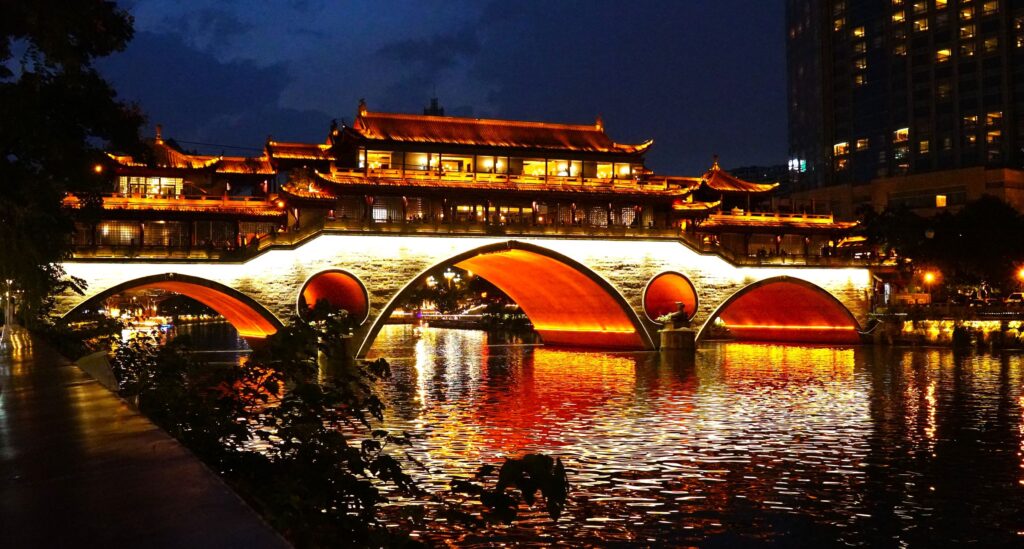
From Jiuyan Bridge itself, Anshun Lang Bridge (安顺廊桥), and the riverside walkway on Binjiang East Road (滨江西路), you get a postcard-worthy composition: a stunning bridge, a shimmering bar street, and boats gently gliding through the water. It’s a view of romance, nostalgia, and modern energy all at once.
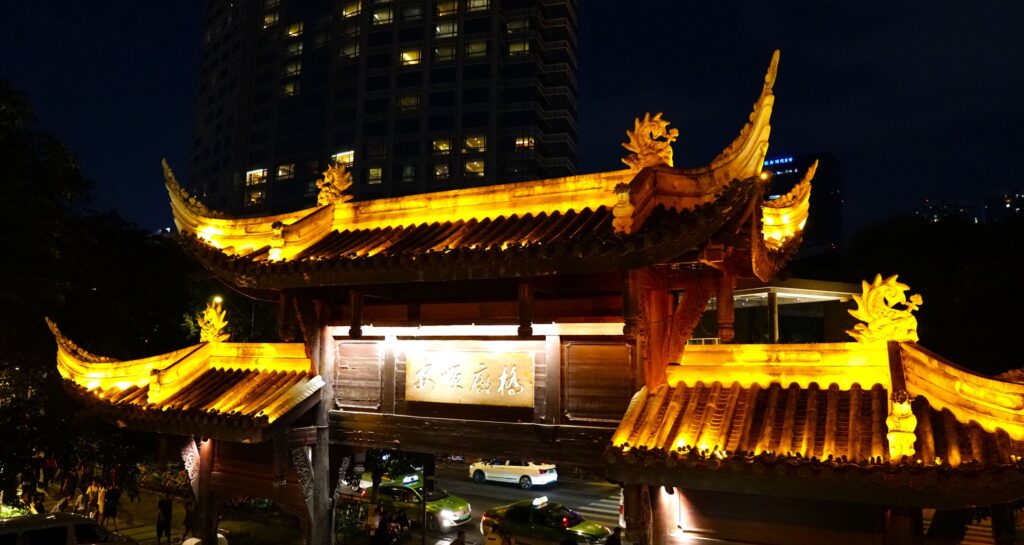
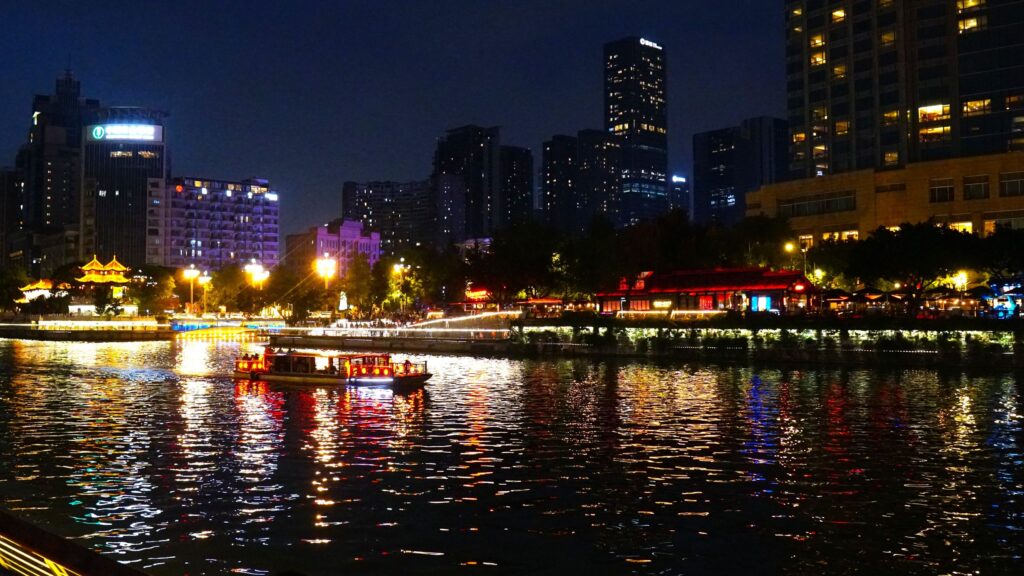
Bar Street (酒吧一条街): The Soul of Chengdu’s Nightlife
Jiuyan Bridge’s Bar Street (酒吧一条街) has been a nightlife staple for over a decade, with over a hundred bars lining a few hundred meters along the river. Many of these bars have remained unchanged despite changes in ownership, preserving their distinctive styles and vibes.
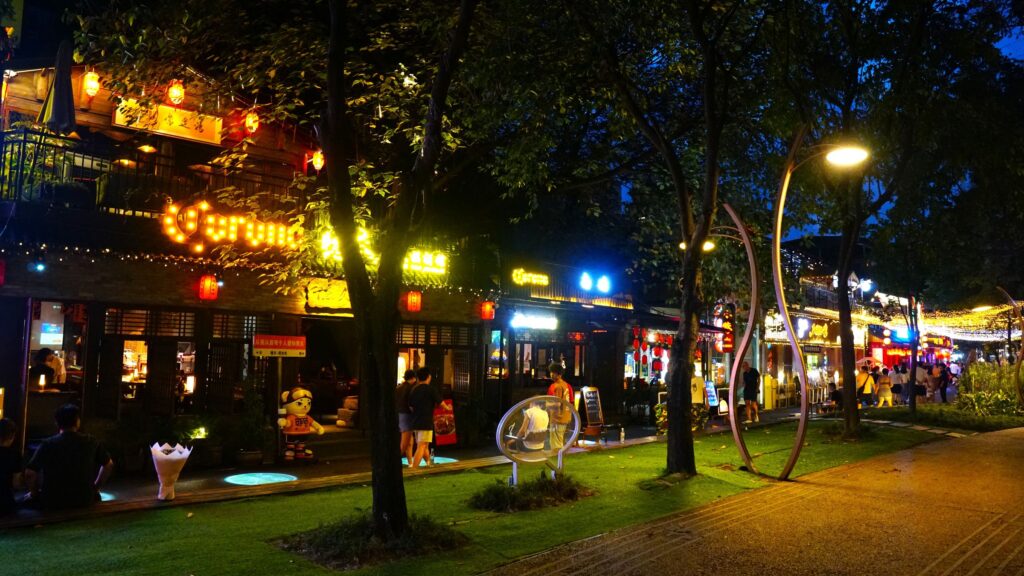
Thanks to its proximity to universities, the area has long been associated with a bohemian bar-and-café culture. Whether you sip quietly in a cozy corner, lost in the intimate melodies of a live singer, or have a wild night of revelry with friends, here – you’ll find the right rhythm to lose yourself in. The night stretches on, the city never sleeps, and neither do the hearts unwilling to say goodbye.
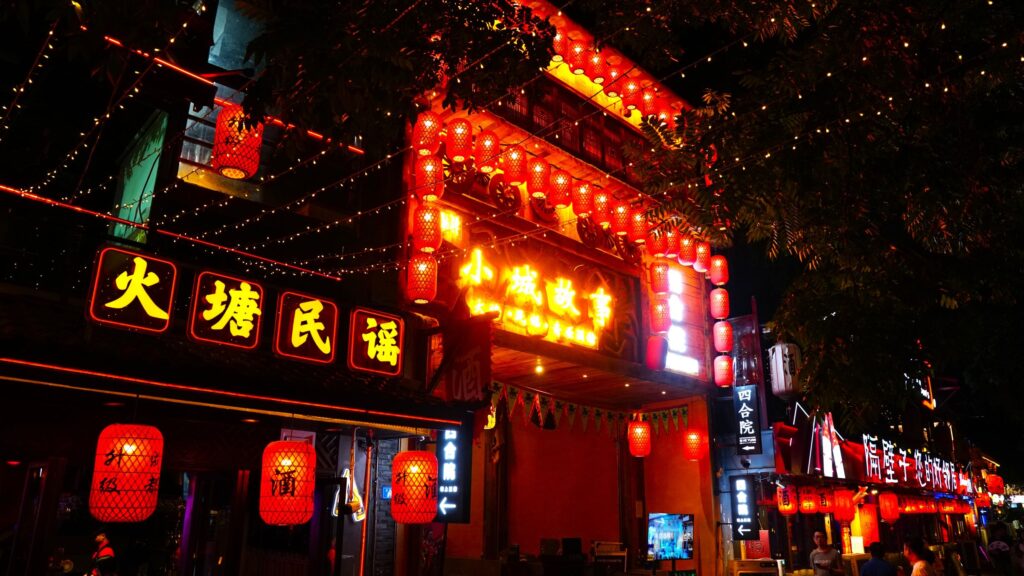
Midnight Bites: The Best Late-Night Eats
No night out in Chengdu is complete without some late-night street food. Zhimin Road (致民路) and Hongwasi (红瓦寺) are known as Chengdu’s classic food streets, offering a feast of flavors and some must-try midnight snacks: Chuan Chuan (串串, skewered meats and vegetables in fiery hot pot broth, Leng Dan Bei (冷啖杯, cold dishes with pickled meats and seafood, perfect with beer), smoky, tender Roast Rabbit (烤兔) with Sichuan spices, juicy, spicy Crayfish (小龙虾), Grilled BBQ (烧烤) with mouthwatering seasonings.
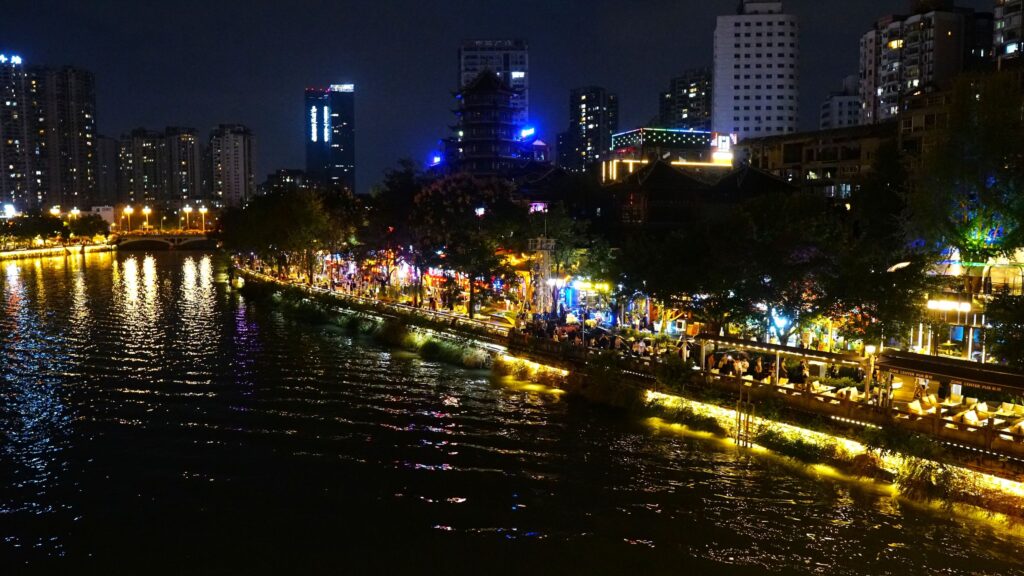
For something simpler, grab a bowl of Chengdu-style noodle soup:
Beef Rice Noodles (牛肉粉) – Rich, beefy, spicy broth with silky rice noodles and umami, melt-in-your-mouth braised beef.
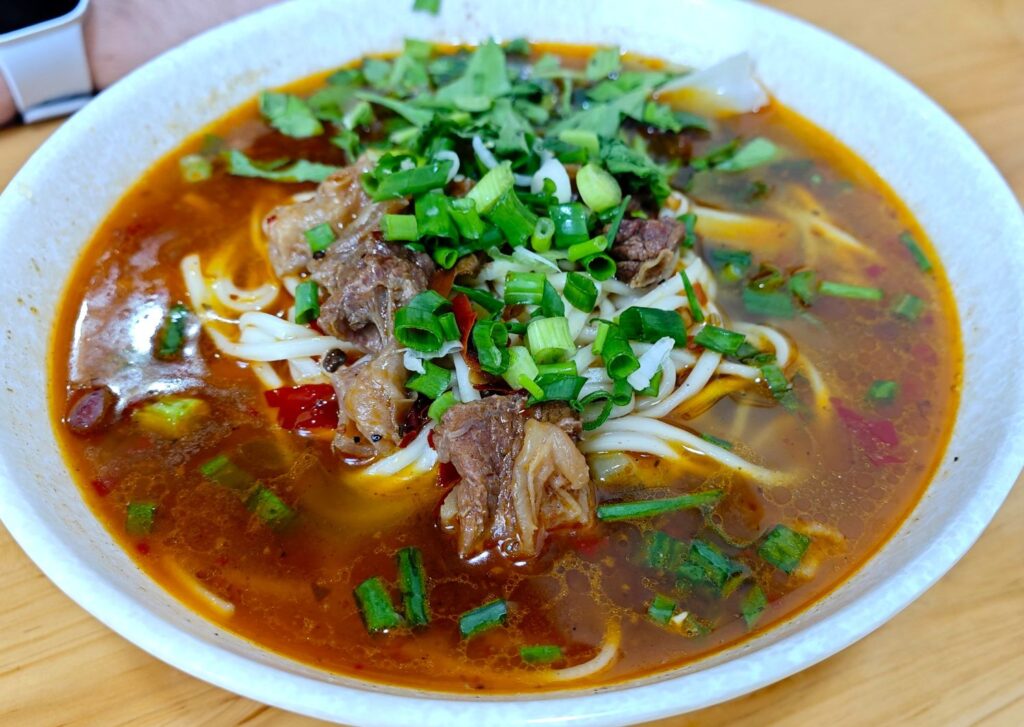
Duck Intestine Noodles (鸭肠粉) – A spicy, numbing noodle soup with tender, springy duck intestines and fragrant chili oil.
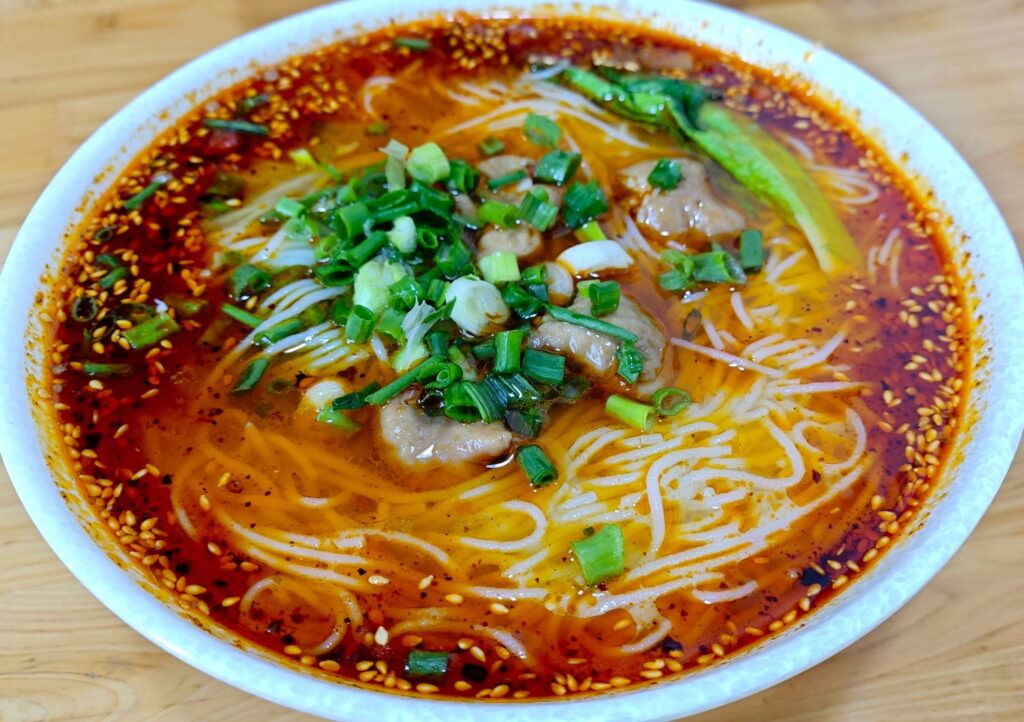
Or, if you’re feeling extra hungry, step into a small stir-fry restaurant (小炒馆) and try some Chengdu classics:
Shuizhu Beef (水煮牛肉) – Succulent slices of beef immerse in a fiery red broth, brimming with the bold, numbing heat of Sichuan peppercorns and fiery dried chilies.
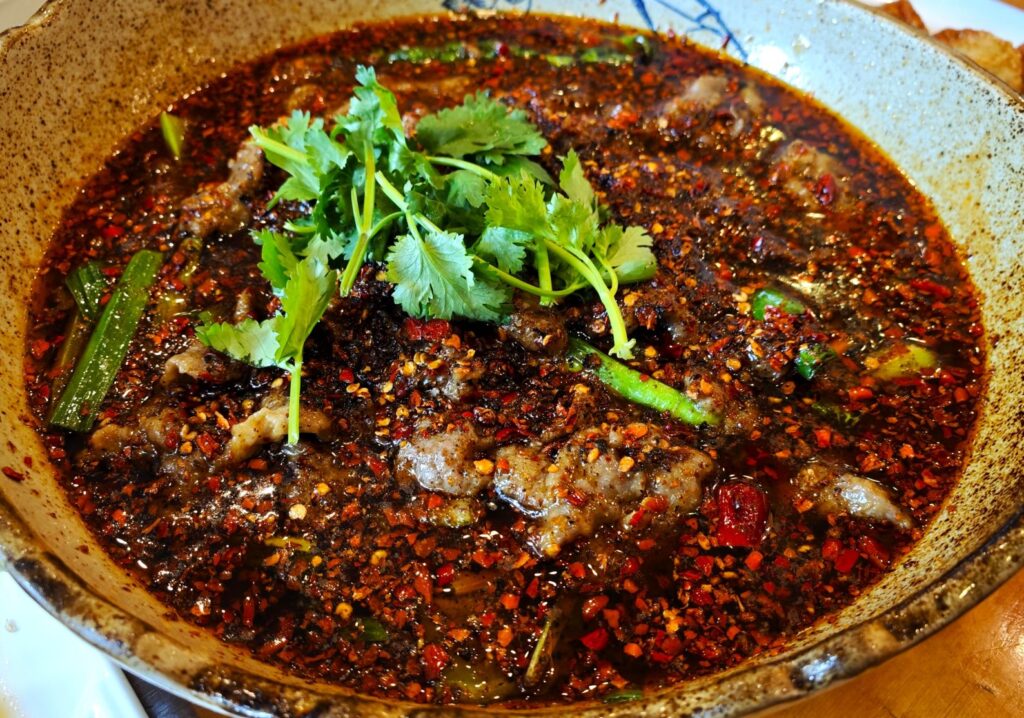
Each bite is tender, melting in your mouth, while the broth, rich and aromatic, delivers heat and spice that tingles your senses.
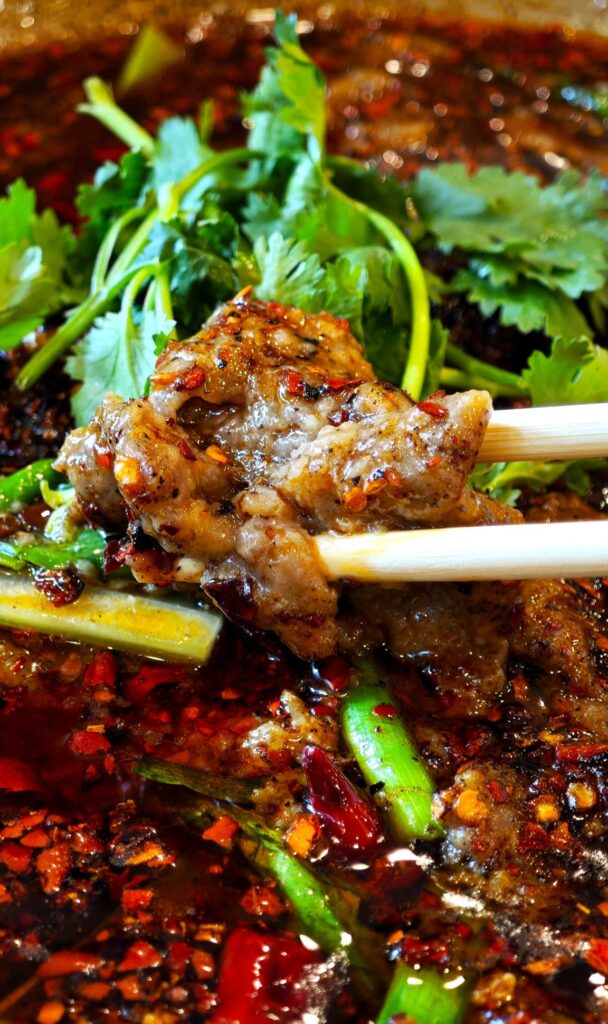
Stir-fried Rabbit with Green Peppers (青椒炒兔肉) – This dish features lean, delicately tender rabbit meat that soaks up the earthy flavors of the stir-fried green peppers. The fragrant, smoky peppers perfectly complement the rabbit’s subtle flavor.

Chive Pockets (韭菜盒子) – Golden and crispy on the outside, these pockets reveal a flavorful filling of juicy, garlicky chives and savory, spiced meat.
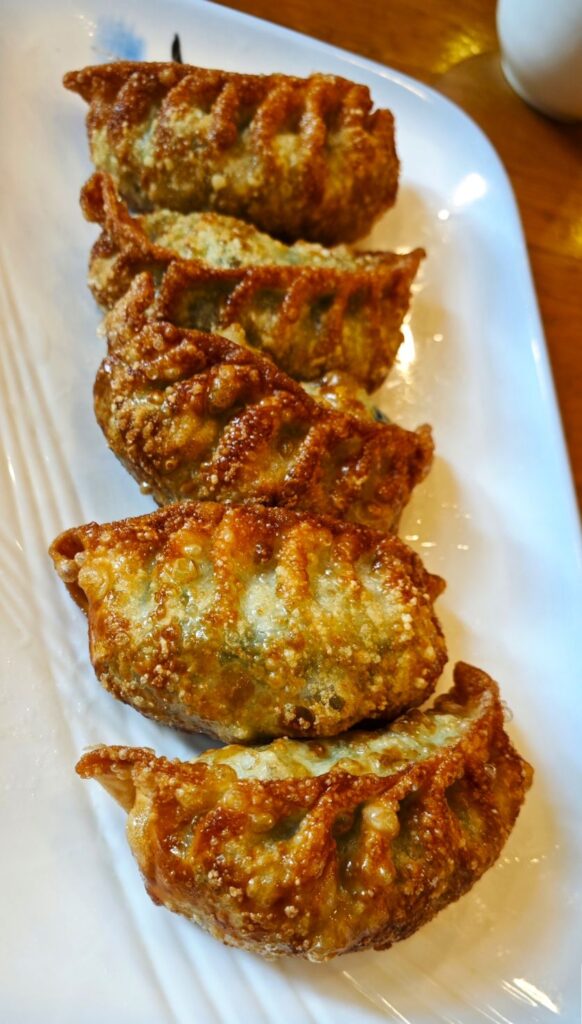
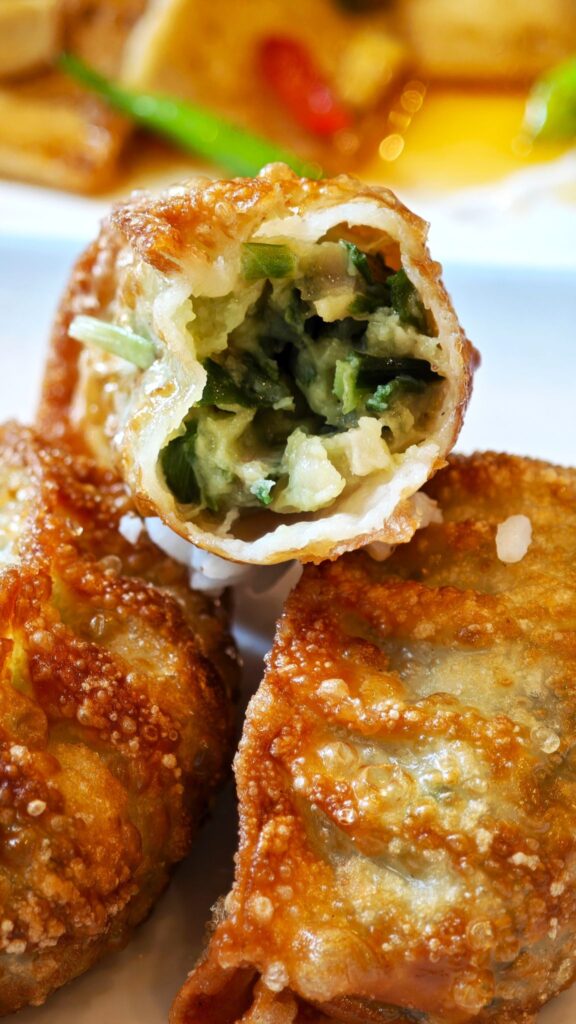
Stir-fried Pork Belly with Hangjiao Peppers and Tofu (杭椒五花肉炒香干)
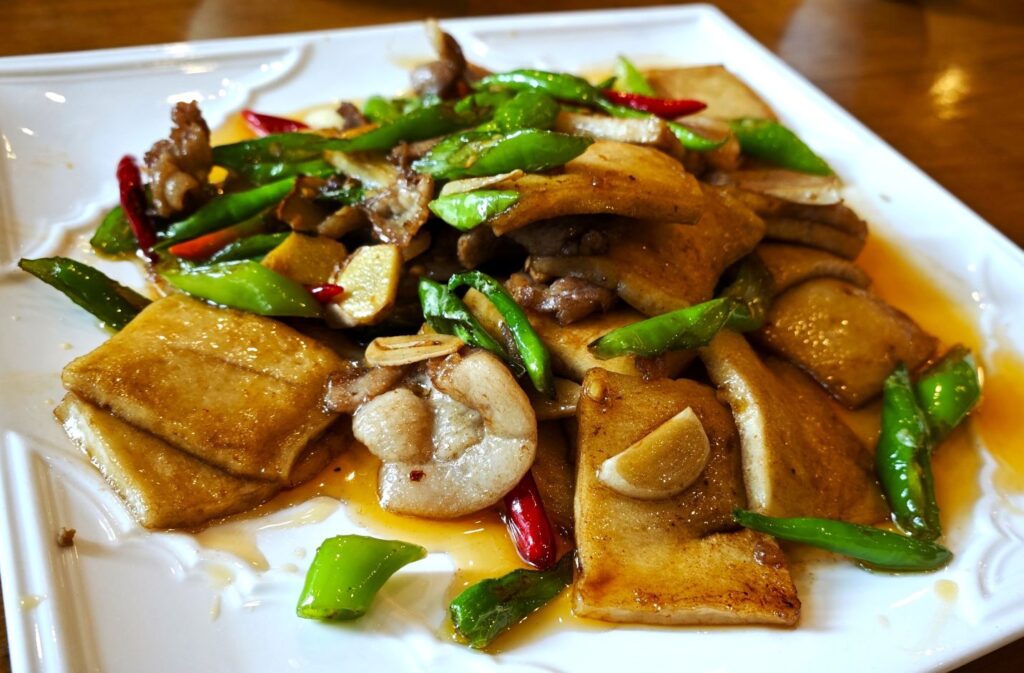
Crispy, juicy pork belly is paired with soft, smoky tofu, absorbing the rich flavors of the stir-fry. Hangjiao peppers, with their sharp, fragrant heat, add excitement to the dish, giving every bite a delicious mix of savory, smoky, and spicy notes that make it irresistible.
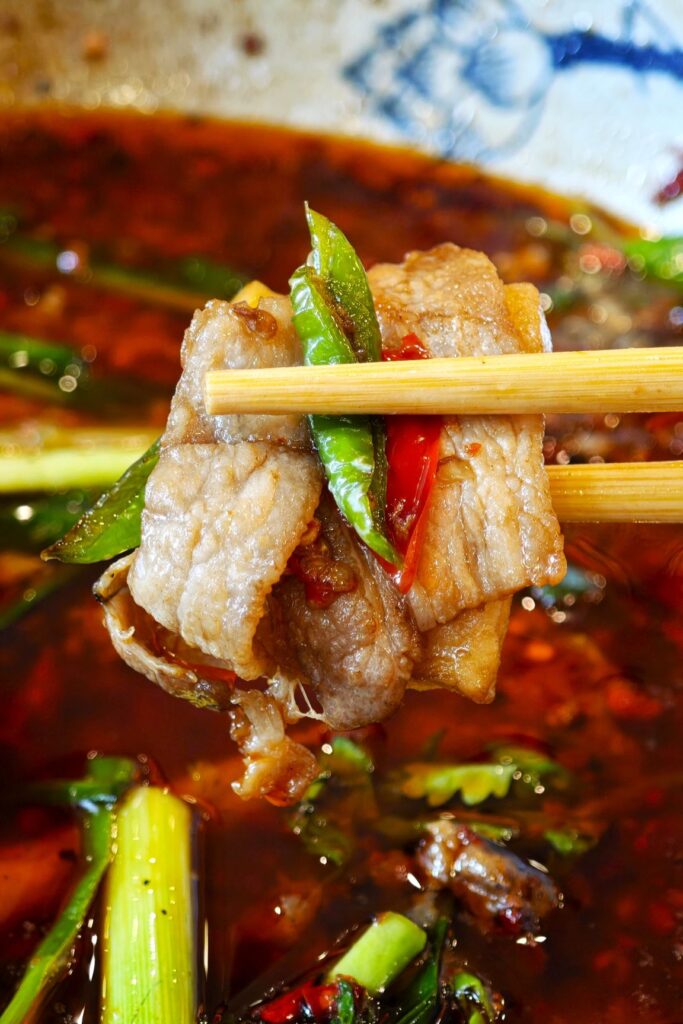
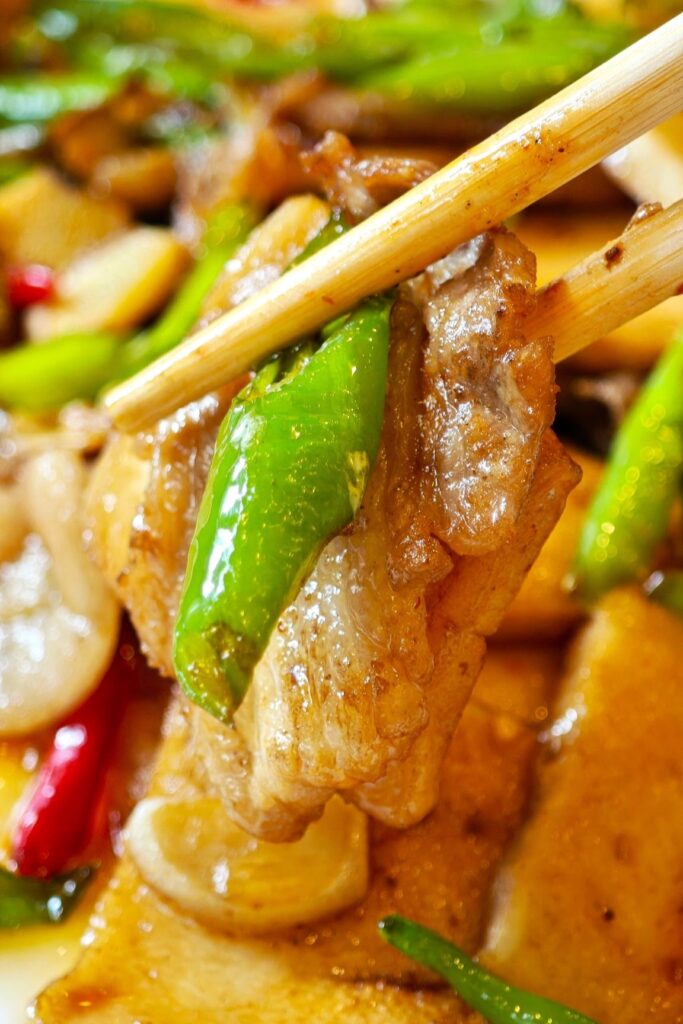
We hope this article has been a helpful guide, packed with all the details and tips you need to make the most of your future trip to this fascinating city. Thank you for taking the time to read it! We’re excited to share with you our Chengdu Day 2 adventure, where we will explore the majestic Mount Qingcheng and witness Dujiangyan’s otherworldly “Blue Tears” – an ethereal, glowing blue water at dusk. Stay tuned for more!
